Homemade Baguette
There’s something undeniably alluring about a freshly baked homemade baguette! A golden-brown crackling crust and a soft delicious crumb. Homemade bread may take some time but it is certainly worth it!
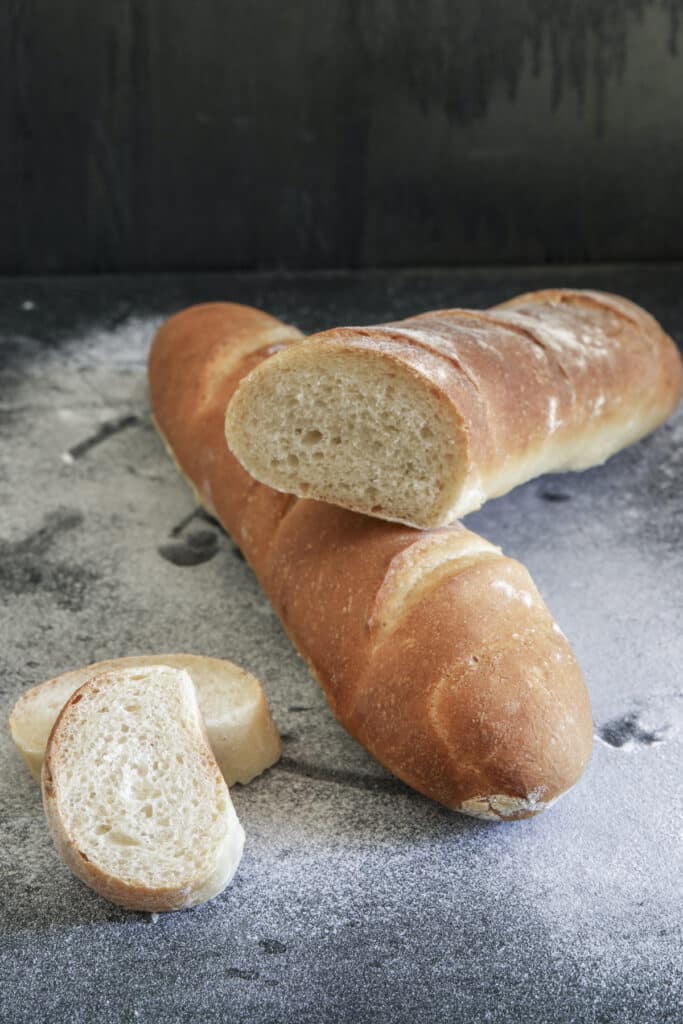
I haven’t made homemade bread in a while, and to tell the truth there really is nothing like fresh bread out of the oven, from a Traditional Italian bread to a simple No Knead Bread to one of my favorite Focaccia breads. So I just knew I had to make this homemade Baguette next, and also because it was a request from a reader!
Recipe Ingredients
- Water – Always use warm water, make sure the temperature is between 98-105F (36-40C). Never use hot or you will kill the yeast and with cold water the yeast will take forever to rise.
- Flour – I usually use all purpose flour or bread flour. Bread flour will produce a chewier crust.
- Yeast – I like to use active dry yeast for this recipe.
- Salt – Helps to flavour the bread.
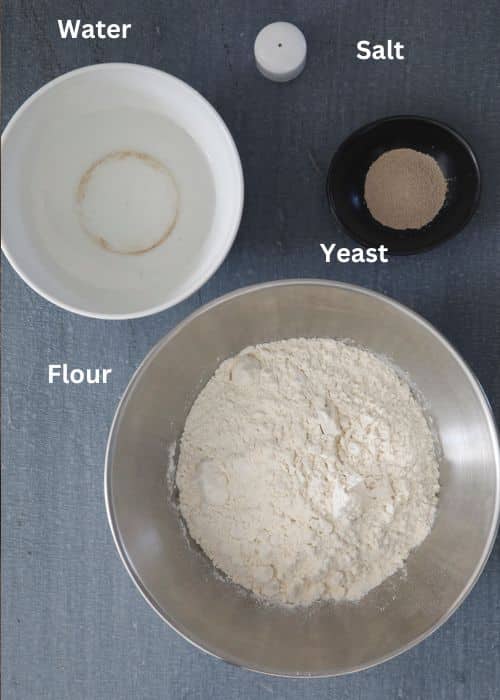
What Is The Best Flour To Use?
For this recipe you are going to need a strong all purpose or bread flour, for a chewier crumb, choose bread flour. Make sure whichever you use it has at least 11.5% protein or more.
Origin of the Baguette
The baguette, is a symbol of French culinary culture, it has a rich history dating back to the 18th century. Its name, which translates to “wand” or “stick,” is a nod to its slender, elongated shape. Over the years, it has become a staple in households worldwide, cherished for its versatility and ability to elevate any meal.
How to make a Baguette Recipe
Start by making the poolish, in a medium bowl add the water, sprinkle the yeast on top and let sit. Then stir to combine, add the flour and mix just to combine. Cover the bowl with plastic wrap and let rest either at room temperature or in the fridge if your house is warm.
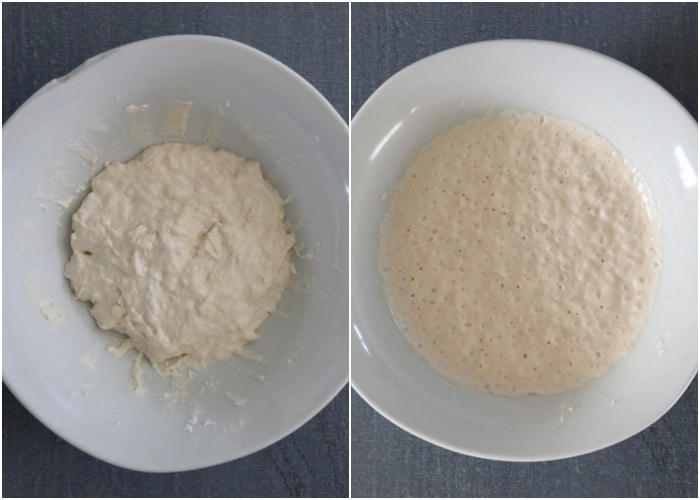
Once the resting period has ended, in the stand mixer add the water and sprinkle the yeast on top, let sit,m then stir to combine. Add the poolish and the flour, start to knead with the dough hook.
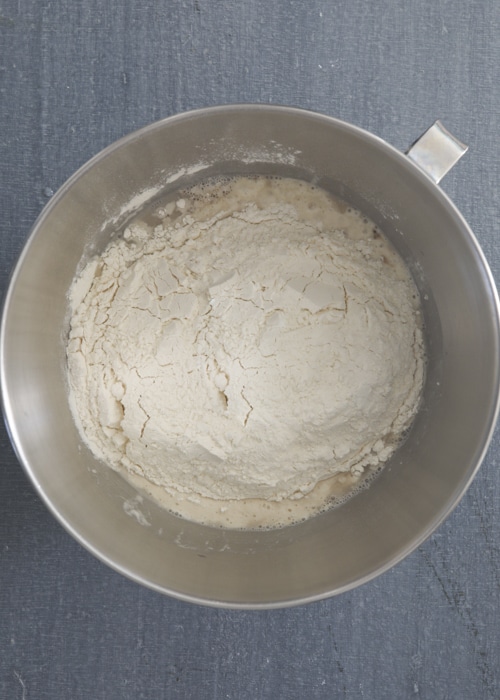
Add the salt, and knead until the dough is smooth and compact. It will be a bit tacky, if it is overly sticky then add a bit more flour.
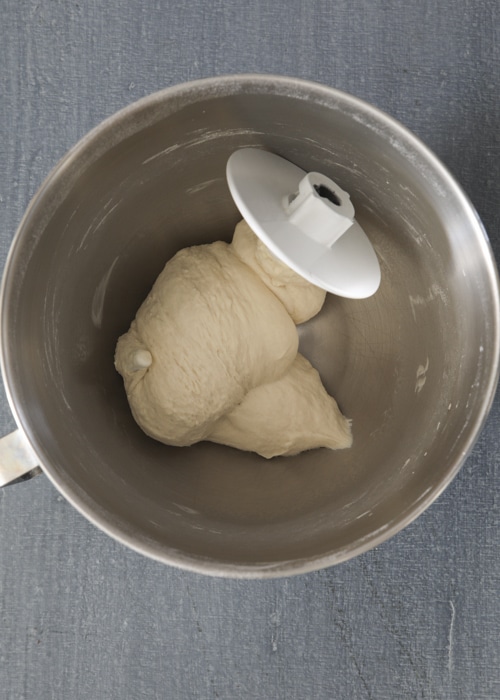
Move the dough to a lightly floured flat surface, form into a ball and place in a lightly oiled large bowl. Cover the dough and let it rise in a draft free warm place doubled.
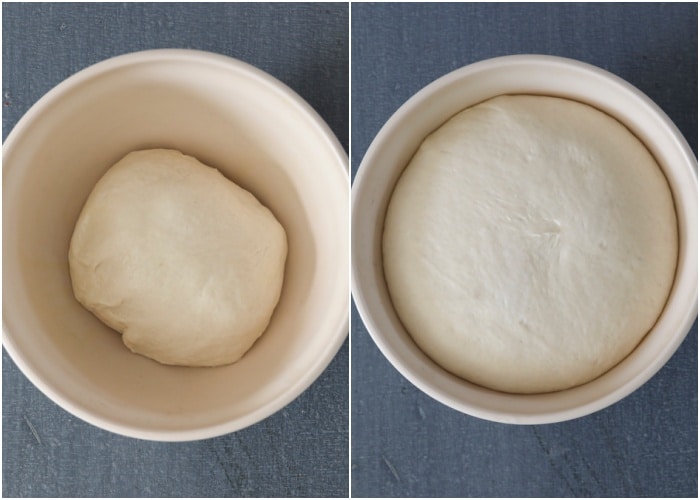
Move the dough to a lightly flat surface, divide into two equal pieces, cover with a clean tea towel and let the dough rest.

Shape the two parts into baguettes, be sure that the seam is closed well, place on a piece of parchment paper and fold the paper to separate them. If you have a baguette pan, then be sure to dust it with flour so the dough doesn’t stick.

Cover the baguettes and allow them to proof. Twenty minutes before the time has passed pre-heat the oven and place an empty pan on the bottom shelf of the oven. If you use a baking stone then place the stone in the oven at the same time, on the middle shelf of the oven. You can also do this with an upside down baking sheet or tray.

Score the top of the baguette, but before placing the bread in the oven pour some boiling water into the pan, place the bread on the stone if using or leave on the parchment paper on the baking sheet.
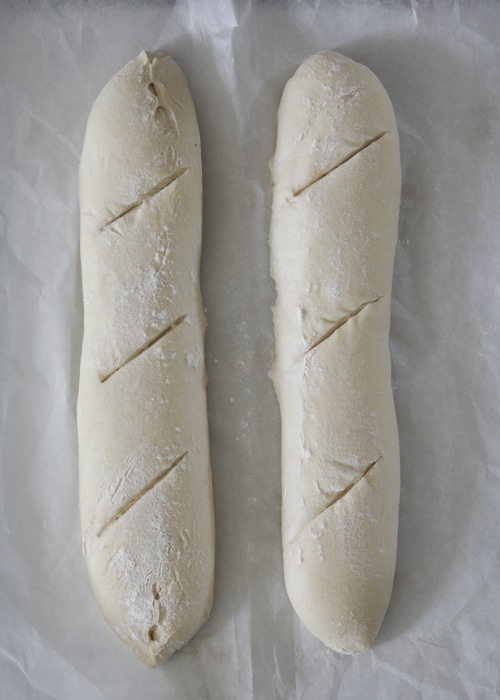
Bake the loaves until golden brown. Immediately move to a wire rack to cool or eat warm.
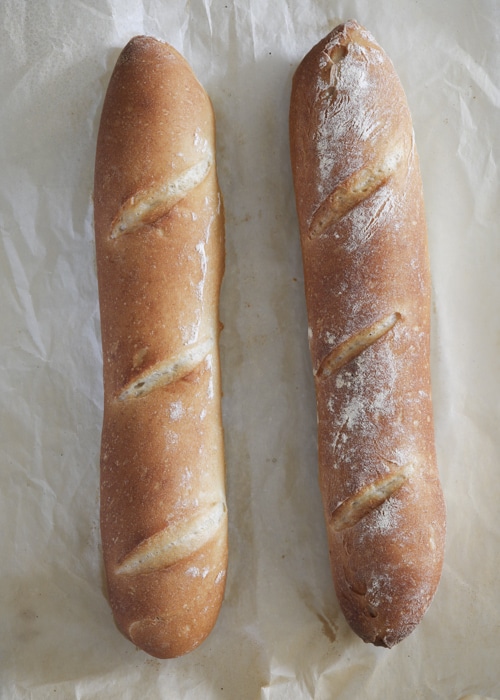
Is The Yeast Active?
The yeast you are using could be old or dead, to tell if the yeast is still active, in a small bowl add a 1/2 cup of water, sprinkle 1 1/2 teaspoons of yeast and a pinch of sugar over the top, stir it up, then let it stand for about 5 minutes.
If the yeast is still active, it will dissolve completely into the water and the liquid will start bubbling. Make sure your water isn’t too hot or too cold. Too hot and you will kill the yeast, too cold and it will take a long time for the dough to rise. The perfect temperature is 100-110F.
What is a poolish?
A Poolish was adopted by the French from Polish bakers. It is made up of equal parts flour and water (100% hydration) and a little yeast. The poolish baguette was introduced to Paris in the early 1960’s and has become the standard in most French bakeries.
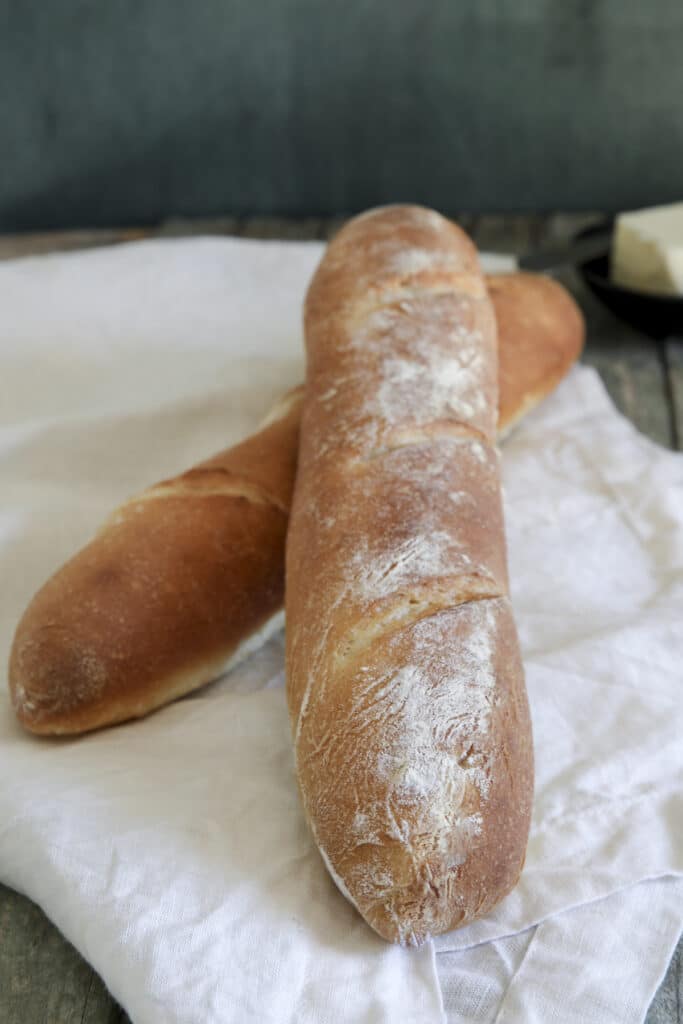
Helpful Tip
- I would recommend making the recipe with the metric amounts.
- Creating the perfect baguette dough requires patience and care. Allowing the dough to rest and rise are crucial steps. A long fermentation period for the poolish is necessary it enhances the flavor.
- I don’t have a Baguette pan so I decided to try and use a piece of parchment paper instead of a towel instead, and it worked perfectly, I didn’t worry about the dough sticking to the towel when I needed to move them, I didn’t have to over flour it either. The fold in the middle, I pulled open and that was the perfect amount of space between the loaves while baking the bread.
How to shape and score a baguette
Shaping the dough into the baguette shape may take a little practice, but it will come. The dough is divided, gently stretched, and rolled into long, slender loaves. Before baking, a series of precise slashes, also known as scoring, are made on the surface. This not only adds an attractive touch but also controls how the bread expands in the oven. Be sure to use a very sharp knife or a razor blade.
Why Do I Add Ice Cubes Or Hot Water?
Adding the ice cubes or hot water to the preheated oven creates steam. They melt and evaporate at just the right time. Once they evaporate and are no longer creating steam this gives the bread a chance to form that lovely outer crust.
I recommend using a thick metal dish rather than a glass or ceramic cake pan if you are using ice cubes as the difference in temperatures can cause the dish to crack. Be sure to place the pan on the very bottom of the oven, the bread will be placed on the middle rack. Just after I add the bread I spray the sides of the oven with water this will also create some much needed steam.
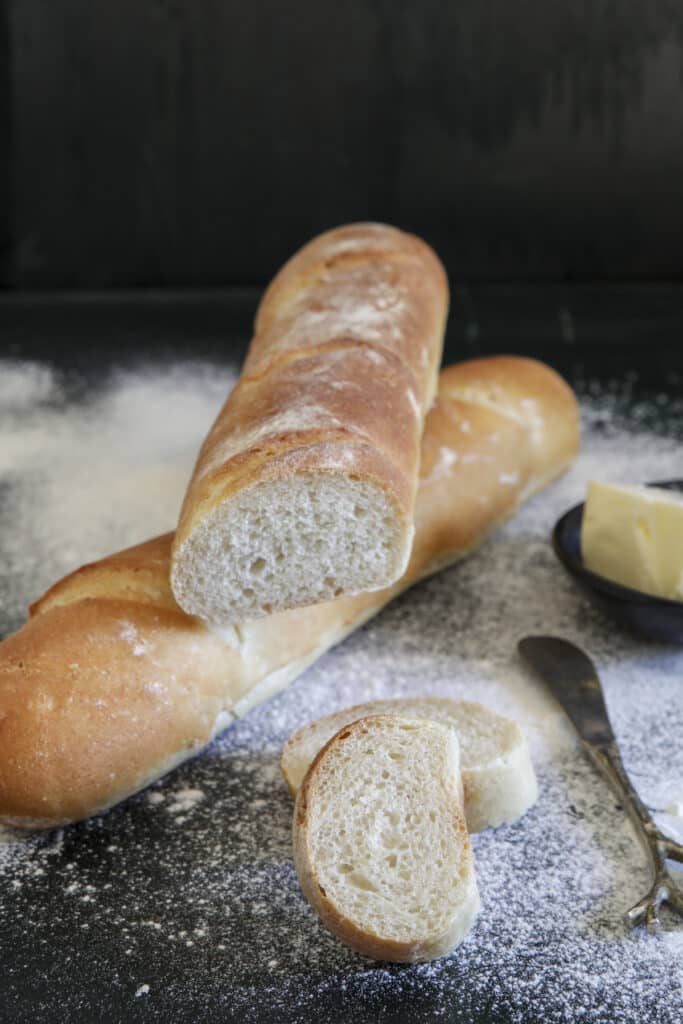
How To Tell When Bread Is Done
You can tell bread is done when you tap on the bottom of the loaf and there is a hollow sound, but if you want to be 100 percent sure, then using a thermometer is your best best, the bread is baked when the centre of the loaf registers 200 – 210F / 93 – 98C.
What is the best time to eat a Baguette?
Freshly baked baguettes are best enjoyed warm from the oven. Whether you’re slathering on butter, creating sandwiches, or pairing them with your favorite cheeses and charcuterie, the simplicity of a baguette enhances any culinary experience.
How to store the baguette
Cool the bread completely, then store it in a plastic airtight bag, storage container, wrap in foil or the Italian way, place the loaf in a paper bag then place it in a plastic bag and close tightly. It can be kept at room temperature for about two to three days.
How to freeze the bread
Let the loaf cool completely, then you can either slice it or leave it whole. Be sure to wrap tightly with foil or freezer safe wrap and then place it in a freezer safe bag or container. Properly stored, it will last for about 3 months.
More Delicious Bread Recipes
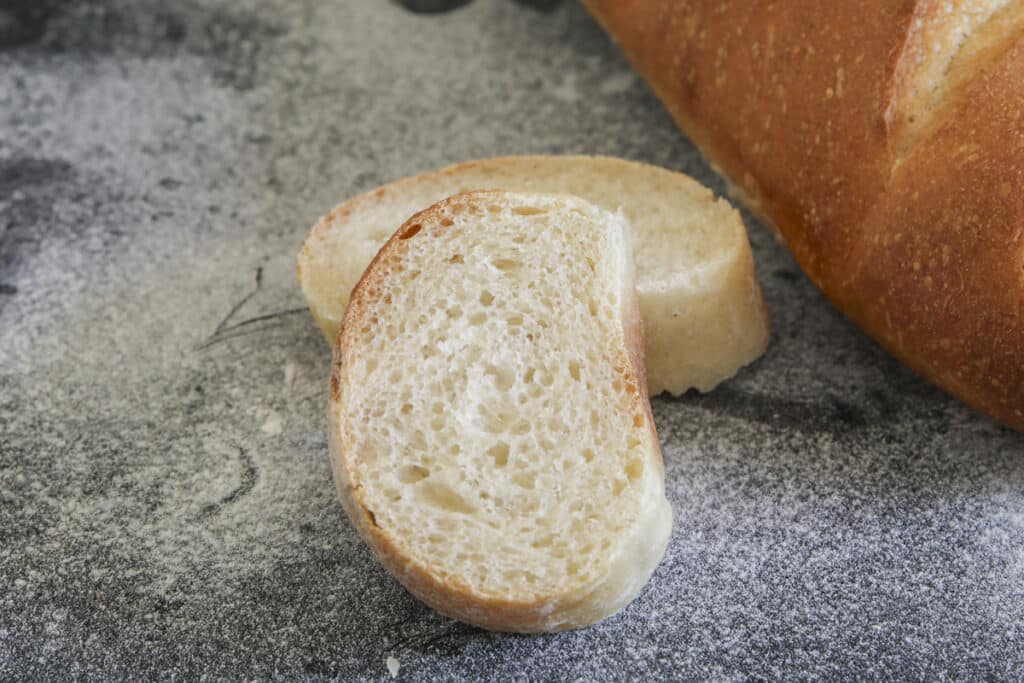
A homemade baguette is the perfect way to start making or continuing with your bread baking journey! So, don your apron, gather your ingredients, and let’s bake some bread! Buon Appetito!
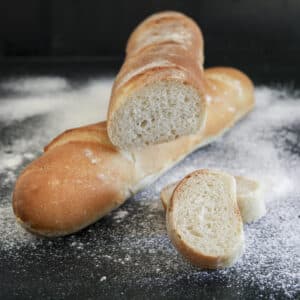
Homemade Baguette
Ingredients
FOR THE POOLISH
- 6⅔ tablespoons water (lukewarm)
- ¼ teaspoon active dry yeast
- 12¾ tablespoons all purpose or bread flour
FOR THE BAGUETTE
- 7 tablespoons water (lukewarm)
- 1 teaspoon active dry yeast
- 1⅔ cups +1 tablespoon all purpose or bread flour (215 total grams if you want to double the recipe then double this amount)
- 1¼ teaspoon salt
Instructions
FOR THE POOLISH
- In a medium bowl add the water, sprinkle the yeast on top and let sit 10 minutes, then stir to combine. Add the flour and mix just to combine. Cover the bowl with plastic wrap and let rest either at room temperature or in the fridge if your house it warm for 12-24 hours.
- Once the resting period has ended, in the stand mixer add the water and sprinkle the yeast on top, let sit 10 minutes, then stir to combine. Add the poolish and the flour start to knead with the dough hook on speed #1, add the salt, continue to knead on speed #2 for 6-8 minutes, until the dough is smooth and compact. It will be a bit tacky, if it is overly sticky then add a bit more flour, or you could add a bit more flour when forming into a ball.
- Move the dough to a lightly floured flat surface, form into a ball and place in a lightly oiled large bowl. Cover the dough and let it rise in a draft free warm place for 2-3 hours, until doubled.
- Move the dough to a lightly floured flat surface, divide into two equal parts, cover with a clean tea towel and let it rest for 10-15 minutes.
- Place a dough part on a lightly floured flat surface and gently pat into a rectangle fold the top half into the middle and pinch to close, then bring it down over the bottom, pinch the seams to close well, then shape the dough into the shape of a baguette, by gently rolling the dough, be sure you don't make the baguette longer then your oven! (My oven is on the smaller side therefore my baguettes were shorter). Continue with the second part. place on a piece of parchment paper and fold the paper to separate them, although they should be touching the paper. If you have a baguette pan, then be sure to dust it with flour so the dough doesn’t stick.
- Place the baguettes on a piece of parchment paper and fold the paper to separate them, they should be touching the paper. (see photos) If you have a baguette pan, then be sure to dust it with flour so the dough doesn’t stick. Sprinkle the baguettes with a little flour, cover and let rise for approximately one hour in a warm draft free area.
- Twenty minutes before the time has passed pre-heat the oven to 420F / 220C, and place an empty pan on the bottom shelf of the oven. If you are using a baking stone then place the stone on the middle shelf.
- Score the top of the baguette, brush off any extra flour, but before placing the bread in the oven pour a cup of boiling water or 4 or 5 ice cubes into the pan, place the bread on the stone if using or leave on the parchment paper on the baking sheet. I like to spray the sides of the oven with water this will also create some much needed steam.
- Bake the loaves for approximately 15 minutes or until golden brown. Immediately move to a wire rack to cool or eat warm. Enjoy!
I didn’t see how it said something about the ice in a separate container put underneath the bread on the lowest shelf. I had to discover that afterwards in a different section. I really did not like the misstep in not including that in the directions and I know I’m going to have a doughy buagette from ice water in the same pan…
Hi Cherie, it’s all written in the instructions.
Hi Rosemary….This is a question about the bagels. I made them today and they came out very good, but..the dough was slightly dry and not smooth and I had to knead most of the time by hand because my stand mixer was jumping because the dough was not sticky, but they still came out good. What did I do wrong? I added the exact measurement of ingredients. I will make them again but I won’t add all the flour at once. Any suggestions? Thanks, Donna
Hi Donna, I don’t think you did anything wrong, different flours absorb water differently, if you find the dough too dry then add a bit more liquid. The dough should be a little bit tacky, so yes you needed a bit more liquid, add a tablespoon at a time. I hope that helps. Take care!
Where is the weight version?
Hi Roberta, in the recipe card where it show US customary beside it is Metric, click on that and weight comes up. I hope you enjoy it!